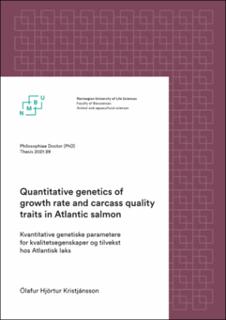| dc.description.abstract | Quantitative genetic parameters of quality traits and growth rate in Atlantic salmon are commonly recorded at a target average market body weight (4-5 kg) at which the individuals are at the same age, which is less labour demanding than recording the quality traits through repeat slaughtering of fish at same body weight, especially for fish reared in net-cages in the sea. Published estimates of genetic parameters for quality traits recorded on fish of the same age indicate a relatively high positive genetic correlation between growth rate and fillet fat and negative correlation between growth rate and visceral fat as well as between growth rate and fillet pigment. Since the most likely breeding goal for quality traits is their value at the same body weight and the quality traits should ideally be recorded on fish at the same body weight.
The first paper aimed to estimate a reliable genetic parameter for growth rate, fillet fat, fillet pigment, and visceral fat (index) based on traits recorded on fish of about the same body weight. That was possible since the fish population were reared in tanks onshore, which allowed slaughter and recording of only the largest fish at several repeated and following slaughter events. For comparison, another group of individuals from the same families were slaughtered and recorded at the same age. The recorded data were analysed with a Bayesian statistical model. The model aims to account for selecting only the largest fish at each slaughter event. The model uses Gibbs sampler, which assigning a most likely growth rate record to the non-slaughtered and non-recorded fish at each slaughter event. For the fish recorded at about the same body weight, the genetic correlations between growth rate and the three other traits were very different from those obtained based on data recorded at the same age; and the latter estimates were similar to published estimates.
In the second paper, the main objective was to investigate to what extend the Bayesian model in the first paper managed to account for the mentioned selection in the data and thus produce unbiased genetic parameters analysed using stochastic simulation. Additionally, were investigated the effect on the estimated parameters of performing a different number of slaughter events and different increase in fillet fat with increasing age or body weight of the fish. It was concluded that the Bayes model did manage to correct for selection in the trait growth rate, at least for a population of 2000 animals. For 2000 individuals was found that he appropriate number of slaughter events was six or more, to obtain unbiased parameter estimates. Since the accuracy and genetic correlation did not change much by performing more samplings than six. Then the magnitude of the genetic correlation between growth rate and fillet fat become more different from the genetic correlation between fillet fat an growth rate obtained at same aged individuals and the difference increased, the more the fillet fat increases with the age or body weight of the fish.
In the third paper, the aim was to study how to obtain genetic parameters and breeding values for traits recorded on fish slaughtered at the same age comparable to those obtained when slaughtering the fish at the same body weight. It was found that if the breeding goal is to reduce fillet fat and increase growth rate, adjusting fillet fat for body weight gives a higher genetic gain in growth rate and a minor reduction in fillet fat than performing no adjustment of the fillet fat records. However, if the breeding goal is to increase both traits, no adjustment of fillet fat for body weight should be performed. That was also the conclusions when applying the same adjustment methods on the real data set from the first paper. | en_US |

